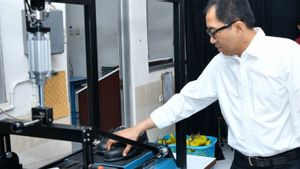JAKATA - High resolution images of human metabolism have been caught on camera for the first time. This is possible thanks to a new technique that can track glucose metabolism in a single cell. Tracking glucose can provide insights and even new therapies to treat cancer – a disease that often disrupts cellular metabolism.
This new technology combines the transfer of fluorescence resonance energy (Fret) between two light-sensitive molecules with machine learning – a form of analysis based on the idea that computer systems can 'learn' from data, making analysis more accurate.
This technology has allowed Yun Fang and his team at the University of Chicago to visualize glucose metabolism – glycolysis. The team genetically engineered human cells to express specific Fret biosensor molecules that glow when glucose is broken down, allowing scientists to capture the process on camera using a fluorescent microscope.
Glucose is a vital source of energy for almost all cell types, but the process of glycolysis in cancer often goes wrong. This can contribute to the diseased state of malignant cells, supporting their ability to move, grow, and divide.
By pairing Fret's technology with a new machine learning algorithm, Fang's team was able to obtain images of glycolysis at previously unattainable resolutions, showing exactly which parts of the cell are using glucose in real time.
"Now we can see and understand details inside cells, such as certain areas of the cell where glycolysis is increased," Fang said. “This is a major technological innovation.”
New machine learning approaches to existing Fret technologies have opened up new experimental possibilities. Glucose metabolism can now be observed in conjunction with other visible cell processes that allowed the team to show that some human cells consume more glucose when they move and twitch – something that was not possible to demonstrate in one previous experiment.
Improperly regulated metabolism can cause some cancer cells to metastasize and invade new tissues. This new technique will help scientists better understand the relationship between these disease processes, and could help discover new therapeutic approaches.
The new technology also led the researchers to find a previously unknown cell surface receptor capable of taking up glucose.
"Coupled with existing technology, this (machine learning approach) will help further our understanding of how glucose and other key energy molecules affect metabolic rewiring in cancer development, and could be used to develop new cancer drug targets," said Gemma Beasy of Quadram. Institute, which studies the effects of glucose metabolism on prostate cancer. "This is a tremendous step forward in technology that can be used in cancer research."
Alongside cancer research, wider applications of Fret-based machine learning technology have been explored, including helping patients whose immune systems overreact to Covid-19.
The English, Chinese, Japanese, Arabic, and French versions are automatically generated by the AI. So there may still be inaccuracies in translating, please always see Indonesian as our main language. (system supported by DigitalSiber.id)











